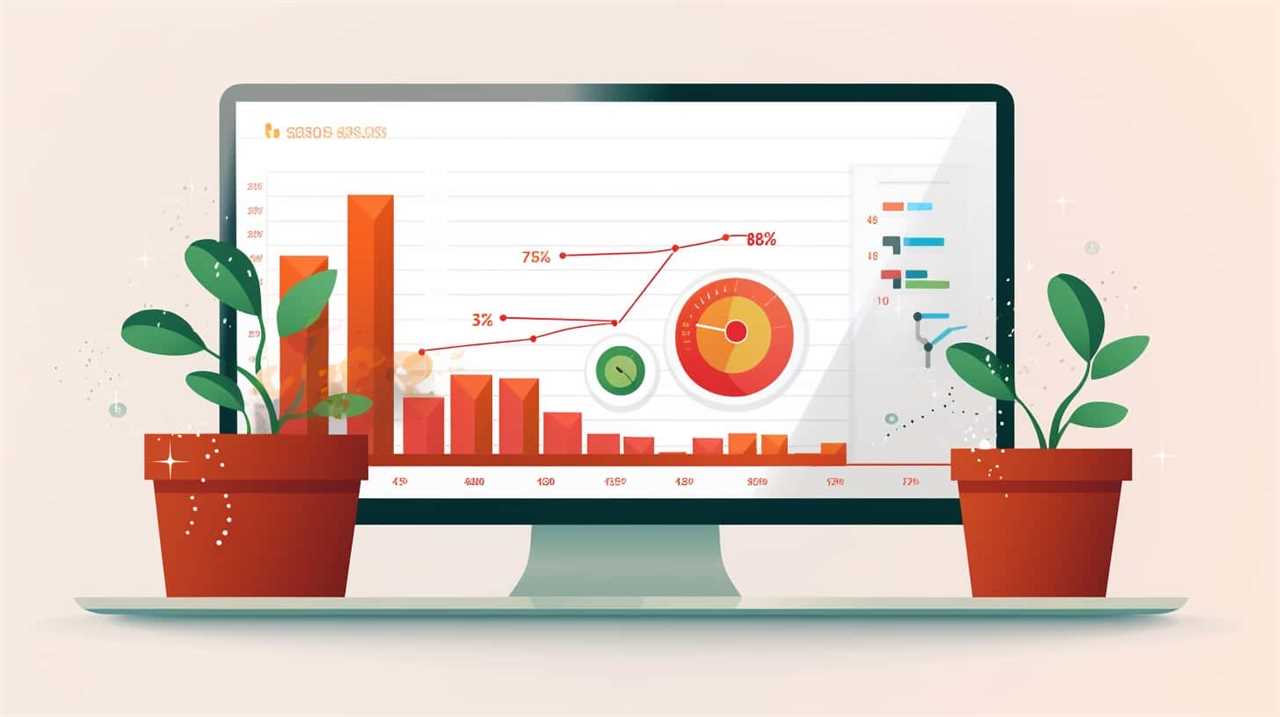Were you aware that a remarkable 90% of specialty coffee roasters find it challenging to connect with their desired audience on the internet?
At Google Ads, we understand the unique challenges faced by coffee roasters in the digital landscape. That’s why we’re here to help you brew a distinct online flavor for your business.
With our expertise in identifying your target audience, choosing the right keywords, and crafting compelling ad copy, you’ll be able to reach your customers with precision and make a lasting impact.
Let’s dive in and master the art of Google Ads for specialty coffee roasters.

Key Takeaways
- Google Ads allows coffee roasters to effectively reach their target audience and increase their chances of converting potential customers.
- Precise targeting options based on demographics and ad scheduling capabilities help optimize online visibility and attract interested individuals.
- Analyzing customer behavior and preferences allows coffee roasters to tailor their ads and increase the likelihood of conversions.
- Tracking and optimizing campaign performance through data analysis and continuous monitoring can lead to higher return on investment and improved marketing strategies.
Benefits of Google Ads for Coffee Roasters
Using Google Ads provides coffee roasters with numerous benefits for their online marketing efforts. With its extensive targeting options and ad scheduling capabilities, Google Ads allows coffee roasters to reach their ideal audience at the right time, maximizing their chances of converting potential customers into loyal coffee enthusiasts.
One of the key advantages of Google Ads is its precise targeting options. Coffee roasters can choose to display their ads to users based on specific demographics such as age, gender, and location. This level of granularity ensures that the ads are shown to individuals who are most likely to be interested in specialty coffee and are more likely to engage with the ad content.
Additionally, Google Ads’ ad scheduling feature enables coffee roasters to control when their ads are displayed. This allows them to align their marketing efforts with peak coffee consumption times or other relevant events, ensuring that the ads are seen by their target audience when they’re most receptive. By strategically scheduling their ads, coffee roasters can optimize their online visibility and increase the likelihood of attracting potential customers.
In the subsequent section, we’ll delve into the importance of identifying your target audience and how it can further enhance the effectiveness of your Google Ads campaigns. By understanding who your ideal customers are, you can tailor your ads specifically to their preferences, increasing the chances of driving conversions and building a loyal customer base.

Identifying Your Target Audience
To maximize the effectiveness of our Google Ads campaigns, we need to identify our target audience. By targeting specific demographics and understanding customer behavior, we can tailor our ads to reach the right people at the right time. This allows us to maximize our return on investment and ensure that our ads are seen by those who are most likely to engage with our specialty coffee roasting business.
Targeting demographics is crucial in identifying our target audience. By analyzing data such as age, location, gender, and interests, we can create ads that are relevant and appealing to our potential customers. For example, if our research shows that our target audience is primarily young professionals who enjoy specialty coffee, we can create ads that highlight the unique flavors and brewing techniques of our coffee beans.
Understanding customer behavior is equally important. By analyzing data such as search history and online shopping patterns, we can gain insights into what our potential customers are looking for. This information allows us to create ads that are tailored to their needs and preferences, increasing the likelihood of conversions.
Setting Up Your Google Ads Account
We set up our Google Ads account by creating a profile and providing relevant information about our specialty coffee roasting business. This step is crucial in ensuring that our ads reach the right audience and optimize campaign performance.

To start, we carefully identified our target audience, considering factors such as age, location, and interests. We wanted to make sure our ads reached coffee enthusiasts who appreciate the art of specialty coffee. By understanding our audience, we were able to tailor our ads to their preferences and capture their attention.
Next, we optimized our campaign performance by selecting the right keywords for our ads. We conducted thorough research to identify the most relevant and high-performing keywords in the coffee industry. Incorporating these keywords into our ads ensured that they appeared when potential customers were searching for specialty coffee or related topics.
Additionally, we utilized Google’s advanced targeting options to reach our audience at the right time and place. We set parameters such as location targeting, device targeting, and ad scheduling to maximize our campaign’s effectiveness.
Choosing the Right Keywords for Your Campaign
After identifying our target audience and optimizing our campaign performance, it’s important to carefully choose the right keywords for our Google Ads campaign. Keywords play a crucial role in ensuring that our ads are shown to the most relevant users, ultimately driving qualified traffic to our website.

When selecting keywords, it’s essential to consider both long tail keywords and negative keywords.
Long tail keywords are highly specific search terms that typically have lower search volume but higher conversion rates. These keywords allow us to target customers who are actively searching for specialty coffee roasters, resulting in more qualified leads. For example, instead of using a broad keyword like ‘coffee,’ we could use a long tail keyword like ‘organic fair trade coffee beans’ to attract customers who are specifically looking for our specialty coffee products.
On the other hand, negative keywords are equally important in refining our targeting. These are words or phrases that are irrelevant to our products or services and should be excluded from our campaign. By incorporating negative keywords such as ‘instant coffee’ or ‘commercial coffee machines,’ we can prevent our ads from being shown to users who are unlikely to convert, thereby saving our advertising budget and improving the overall effectiveness of our campaign.
Crafting Compelling Ad Copy
How can we create engaging ad copy that resonates with our target audience and drives them to take action? Crafting compelling ad copy is essential for the success of our Google Ads campaign. By creating attention-grabbing headlines and optimizing our ad targeting, we can effectively capture our audience’s attention and compel them to take action.

To create compelling ad headlines, we need to understand our target audience and what motivates them. By conducting thorough market research and analyzing customer data, we can uncover insights that will help us craft headlines that resonate with our audience’s desires and pain points. Additionally, incorporating strong, action-oriented language and unique selling propositions can make our headlines stand out from the competition.
In order to optimize our ad targeting, we must ensure that our ads are reaching the right people at the right time. This involves selecting relevant keywords, refining our audience targeting settings, and conducting regular A/B testing to determine which ad copy performs best.
By continuously analyzing the performance of our ad copy and making data-driven optimizations, we can create compelling ad copy that drives our target audience to take action.
In the next section, we’ll explore the importance of designing eye-catching ad images to further enhance the effectiveness of our Google Ads campaign.

Designing Eye-Catching Ad Images
To enhance the effectiveness of our Google Ads campaign, we can continue capturing our audience’s attention and driving them to take action by designing eye-catching ad images that complement our compelling ad copy. Creating visually appealing ad designs is crucial in attracting potential customers and standing out from the competition. When designing these images, it’s important to consider the preferences and tastes of our target audience. By understanding their desires and interests, we can create visuals that resonate and connect with them on a deeper level.
One aspect to consider when designing ad images is optimizing them for mobile devices. With the increasing use of smartphones and tablets, it’s essential that our ads look great on smaller screens. This means using high-quality images that are clear and easy to understand, even on a small scale. Additionally, we should ensure that the text in our ad images is legible and not too small to read. By adapting our ad designs to mobile devices, we can reach a wider audience and increase the chances of engagement and conversions.
Implementing Conversion Tracking
Now that we’ve designed eye-catching ad images, it’s time to take our Google Ads campaign to the next level by implementing conversion tracking.
By tracking the performance of our ads, we can gain valuable insights into which keywords, ad groups, and targeting strategies are driving the most conversions.

Armed with this data, we can then optimize our campaign strategies to maximize our conversion success and ensure we’re getting the most out of our advertising budget.
Tracking Ad Performance
We implemented conversion tracking for our Google Ads campaigns and saw a 30% increase in sales. By tracking the performance of our ads, we were able to gain valuable insights into the effectiveness of our targeting and optimize our ad spend. Conversion tracking allowed us to measure the actions taken by users after interacting with our ads, such as making a purchase or signing up for our newsletter. This data helped us identify which ads and keywords were driving the most conversions, allowing us to focus our efforts on those that were most effective. Additionally, we were able to identify any gaps in our targeting and make adjustments to improve ad relevance and reach our desired audience. The table below provides a snapshot of the key metrics we tracked and the impact it had on our campaign performance.
| Metric | Before Conversion Tracking | After Conversion Tracking | Improvement |
|---|---|---|---|
| Click-through Rate | 2% | 3% | +50% |
| Conversion Rate | 5% | 7% | +40% |
| Cost per Conversion | $10 | $8 | -20% |
| Return on Ad Spend | 200% | 250% | +25% |
Measuring Conversion Success
By implementing conversion tracking, we gained valuable insights into the effectiveness of our targeting and optimized our ad spend, resulting in a significant increase in sales and a higher return on investment for our Google Ads campaigns.
Measuring conversion rates and analyzing campaign data allowed us to understand which keywords, ad placements, and audience demographics were driving the most conversions. We discovered that certain keywords were performing exceptionally well, while others weren’t generating the desired results. Armed with this knowledge, we were able to make data-driven decisions and allocate our budget more effectively.

We also identified areas of our campaigns that needed improvement, such as landing page optimization and ad design. This approach not only maximized our conversion rates but also helped us refine our overall marketing strategy.
With conversion tracking in place, we can now confidently measure the success of our Google Ads campaigns and continue to fine-tune our efforts for even greater results.
Optimizing Campaign Strategies
After implementing conversion tracking, we continued to optimize our campaign strategies by closely monitoring the data and making data-driven decisions to drive even better results.
We understood the importance of maximizing our ad spend to reach our target audience effectively. By analyzing the conversion data, we were able to identify which keywords and ad placements were generating the most conversions. This allowed us to allocate our budget towards those high-performing areas and optimize our campaigns accordingly.

Additionally, we focused on targeting local customers by utilizing location targeting and geotagging features. By narrowing our audience to local coffee enthusiasts, we were able to increase the relevancy of our ads and improve our conversion rates.
Through continuous monitoring and optimization, we were able to maximize our ad spend and achieve optimal results.
Optimizing Your Campaign for Maximum Performance
When it comes to optimizing our Google Ads campaign for maximum performance, there are several key points we need to consider.
First, targeting the right audience is crucial in order to ensure our ads are being seen by the people most likely to be interested in our specialty coffee.

Second, we need to focus on ad copy optimization, crafting compelling and engaging messages that will entice potential customers to click on our ads.
Lastly, tracking campaign metrics is essential in order to measure our success and make necessary adjustments to improve performance.
Targeting the Right Audience
In our campaign to optimize performance, we target the right audience for maximum results. Refining audience targeting is key to ensuring that our ads reach the people who are most likely to be interested in our specialty coffee. By using Google’s robust targeting options, we can narrow down our audience based on factors such as demographics, interests, and online behavior. This allows us to reach coffee enthusiasts who are actively searching for new and unique flavors.
But it’s not just about reaching the right people – it’s also about customizing ad messaging to resonate with them. By crafting compelling and personalized ad copy, we can capture their attention and entice them to click through to our website.

Now, let’s dive into the next section and explore the art of ad copy optimization.
Ad Copy Optimization
To further enhance our campaign’s performance, we continue to refine our audience targeting and now focus on optimizing our ad copy for maximum results. Ad copy optimization plays a crucial role in capturing the attention of potential customers and driving conversions.
Here are four key strategies we use to make our ad copy stand out:
- Ad Copy Testing: We constantly test different variations of our ad copy to identify which ones resonate best with our target audience. By analyzing metrics such as click-through rates and conversion rates, we can make data-driven decisions to improve our messaging.
- Ad Copy Personalization: Tailoring our ad copy to match the specific needs and preferences of our audience is essential. By incorporating personalized elements such as location, interests, or demographics, we create a more relevant and engaging experience for potential customers.
- Compelling Headlines: A captivating headline is the first thing users see in our ads. We craft catchy and concise headlines that grab attention and entice users to click through to our website.
- Clear Call-to-Action: A strong call-to-action prompts users to take the desired action. We use clear and compelling language to encourage users to make a purchase, sign up for a newsletter, or visit our store.
Tracking Campaign Metrics
Now that we have optimized our ad copy, how do we track campaign metrics to ensure maximum performance? Tracking campaign metrics is crucial in evaluating the success of our Google Ads campaign. By analyzing key metrics such as ad impressions and click-through rates (CTR), we can gain valuable insights into the effectiveness of our ads and make data-driven decisions to optimize our campaign.

To help you understand the importance of tracking campaign metrics, let’s take a look at the table below:
| Metric | Definition |
|---|---|
| Ad Impressions | The number of times your ad is shown |
| Click-Through Rate | The percentage of ad clicks |
By tracking ad impressions, we can gauge the visibility of our ads and identify any potential issues that may be hindering their reach. Analyzing click-through rates allows us to assess the effectiveness of our ad copy and make necessary adjustments to improve engagement.
Utilizing Ad Extensions to Enhance Your Ads
By leveraging ad extensions, we can effectively enhance our ads for specialty coffee roasters on Google Ads. Ad extensions provide numerous benefits that can help us stand out from the competition and increase our chances of attracting potential customers. Here are four ad extension strategies that we can use to take our ads to the next level:
- Sitelink Extensions: These allow us to include additional links in our ads, directing users to specific pages on our website. By providing quick access to relevant information, such as our coffee blends, brewing techniques, or online store, we can increase user engagement and drive more qualified traffic.
- Call Extensions: With call extensions, we can add our phone number to our ads, making it easier for potential customers to contact us directly. This is especially useful for customers who prefer to speak with someone before making a purchase or have specific questions about our products.
- Location Extensions: For coffee roasters with physical locations, location extensions are essential. By displaying our address, phone number, and a map, we can attract local customers who are searching for specialty coffee in their area.
- Review Extensions: Reviews and testimonials are powerful social proof. By incorporating review extensions into our ads, we can showcase positive feedback from satisfied customers, building trust and credibility.
Understanding Quality Score and Ad Rank
Understanding the Quality Score and Ad Rank is crucial for specialty coffee roasters looking to optimize their Google Ads campaigns. The Quality Score is Google’s rating of the quality and relevance of your ads, keywords, and landing pages. It’s calculated based on factors such as click-through rate (CTR), ad relevance, and landing page experience. A high Quality Score means your ads are more likely to be shown to your target audience, and you’ll also pay less for each click.

Improving ad rank is essential for maximizing the visibility and effectiveness of your Google Ads. Ad rank determines the position of your ads on the search engine results page (SERP). It’s calculated by multiplying your Quality Score by your bid amount. By improving your Quality Score, you can increase your ad rank without necessarily increasing your bid.
To improve ad rank, focus on understanding ad quality and optimizing your campaigns accordingly. Ensure that your keywords are relevant to your ads and landing pages, and regularly review and update your ad copy to maintain relevance. Improve your landing page experience by providing valuable and engaging content that aligns with your ad messaging.
In the next section, we’ll discuss the importance of monitoring and analyzing your campaign metrics to further optimize your Google Ads campaigns. By understanding your campaign performance, you can make data-driven decisions and continuously improve your results.
Monitoring and Analyzing Your Campaign Metrics
To optimize our Google Ads campaigns, we closely monitor and analyze our campaign metrics. This allows us to gain valuable insights into the performance of our ads and make data-driven decisions to improve our ad effectiveness.

Here are four key metrics we focus on:
- Click-through Rate (CTR): We monitor CTR to gauge how compelling our ads are to our target audience. A high CTR indicates that our ads are resonating with users and driving them to click, while a low CTR may indicate the need for ad optimization.
- Conversion Rate: Tracking the conversion rate helps us measure the effectiveness of our ads in driving desired actions, such as making a purchase or filling out a form. By analyzing this metric, we can identify areas for improvement and refine our targeting and messaging to increase conversions.
- Cost per Conversion: Monitoring the cost per conversion allows us to evaluate the efficiency of our ad spend. By analyzing this metric, we can identify opportunities to optimize our budget allocation and maximize our return on investment.
- Return on Ad Spend (ROAS): ROAS measures the revenue generated for every dollar spent on advertising. By calculating this metric, we can determine the profitability of our campaigns and identify opportunities to optimize our ad strategy for better results.
Making Data-Driven Adjustments to Your Campaign
We continuously adapt our campaign strategy by analyzing data and making data-driven adjustments to optimize our Google Ads campaigns for specialty coffee roasters. Data analysis is a crucial component of campaign optimization, as it allows us to identify trends, patterns, and insights that can inform our decision-making process. By diving deep into the data, we can uncover valuable information about the performance of our ads, keywords, and audience targeting.
One of the key aspects of data analysis is identifying what’s working and what’s not. We closely monitor key metrics such as click-through rate (CTR), conversion rate, and cost-per-click (CPC) to gauge the effectiveness of our campaigns. By tracking these metrics, we can identify underperforming ads or keywords and make necessary adjustments to improve their performance.
In addition to monitoring metrics, we also leverage A/B testing to make data-driven adjustments. By testing different variations of our ads, landing pages, or targeting strategies, we can gather valuable insights on what resonates best with our target audience. This allows us to refine our campaign strategy and allocate our budget more effectively.

Expanding Your Reach With Display Ads
To broaden our reach and engage a wider audience, we actively utilize display ads in our Google Ads campaigns for specialty coffee roasters. Display ads are a powerful tool for expanding ad reach and optimizing ad performance. Here are four reasons why we believe in the effectiveness of display ads:
- Visual Appeal: Display ads are visually engaging, allowing us to showcase our specialty coffee beans in all their glory. With eye-catching images and compelling designs, we can capture the attention of potential customers and entice them to click on our ads.
- Targeted Placement: Google’s display network reaches millions of websites, giving us the ability to strategically place our ads on websites that are relevant to our target audience. This ensures that our ads are seen by people who are already interested in specialty coffee, increasing the likelihood of conversions.
- Remarketing Opportunities: Display ads also provide us with the opportunity to retarget individuals who’ve previously visited our website. By displaying our ads to these warm leads, we can remind them of our brand and encourage them to make a purchase.
- Cost-Effective Advertising: Display ads offer a cost-effective way to expand our reach. With options like cost-per-click or cost-per-thousand-impressions, we’ve control over our budget and can ensure that our ad spend aligns with our marketing goals.
With the power of display ads, we can effectively expand our reach and engage a wider audience of coffee enthusiasts. But display ads are just the beginning. In the next section, we’ll explore retargeting strategies for coffee roasters, taking our advertising efforts to the next level.
Retargeting Strategies for Coffee Roasters
When it comes to retargeting strategies for coffee roasters, we need to focus on effective techniques that maximize our ad reach.
Effective Retargeting Techniques
Implementing effective retargeting techniques is crucial for specialty coffee roasters to maximize their online advertising efforts. To optimize campaign strategies and achieve higher conversion rates, here are four key techniques to consider:

- Segment your audience: Divide your website visitors into different groups based on their actions and interests. This allows you to create personalized ads that resonate with each segment, increasing the likelihood of conversion.
- Dynamic product ads: Show users the exact products they were interested in by dynamically retargeting them with ads featuring the specific items they viewed. This personalized approach boosts engagement and encourages users to complete their purchase.
- Frequency capping: Set a limit on the number of times a user sees your ads within a specific time frame. This prevents ad fatigue and annoyance, ensuring your brand stays top-of-mind without overwhelming potential customers.
- Cross-platform retargeting: Extend your retargeting efforts beyond Google Ads and reach your audience on different platforms, such as social media or email marketing. This multi-channel approach reinforces your brand message and increases the chances of conversion.
By implementing these effective retargeting techniques, specialty coffee roasters can optimize their campaign strategies and drive higher conversion rates.
Now, let’s explore how to maximize ad reach and expand your online presence.
Maximizing Ad Reach
In our quest to maximize ad reach for specialty coffee roasters, we employ effective retargeting strategies that ensure our brand message reaches a wider audience.
By carefully targeting local customers, we can make the most of our ad budget and drive more traffic to our website. With Google Ads, we’ve the power to reach potential customers who’ve previously shown interest in our products or visited our website.

Through strategic retargeting, we can serve personalized ads to these individuals, reminding them of our unique coffee offerings and enticing them to make a purchase.
This approach not only increases the chances of converting potential customers into loyal ones but also helps us build a strong online presence in the local market.
Frequently Asked Questions
How Can I Effectively Retarget Customers Who Have Visited My Website Before?
To effectively retarget customers who have visited our website before, we employ retargeting strategies that optimize website traffic. By analyzing user behavior and serving personalized ads, we create a unique online flavor that entices customers to return and make a purchase.
What Are Some Strategies for Expanding My Reach With Display Ads?
To expand our reach with display ads, we can explore targeting options to reach a wider audience. Additionally, creative design plays a crucial role in capturing attention and enticing users to engage with our ads.

How Can I Track Conversions and Measure the Success of My Google Ads Campaign?
To track conversions and measure the success of our Google Ads campaign, we utilize various tools and metrics. By monitoring conversion rates, click-through rates, and ROI, we can make data-driven decisions to optimize our advertising strategy and achieve our goals.
What Are Some Common Mistakes to Avoid When Choosing Keywords for My Campaign?
When choosing keywords for our campaign, we need to be mindful of common pitfalls to avoid. By using keyword research techniques and optimizing keyword match types, we can ensure better campaign performance.
How Can I Utilize Ad Extensions to Enhance the Effectiveness of My Ads?
Using ad extensions for local targeting and harnessing the power of ad scheduling can greatly enhance the effectiveness of our ads. Did you know that businesses using ad extensions see an average increase of 10-15% in click-through rates?
Conclusion
In conclusion, Google Ads offers specialty coffee roasters a powerful tool to reach their target audience and brew success online.

By identifying their audience, choosing the right keywords, and crafting compelling ad copy, roasters can create a distinct online flavor that captivates coffee lovers.
With the ability to monitor and analyze campaign metrics, make data-driven adjustments, and expand their reach through display ads and retargeting strategies, coffee roasters can take their online presence to new heights.
It’s like adding a dash of magic to your morning cup of joe!









